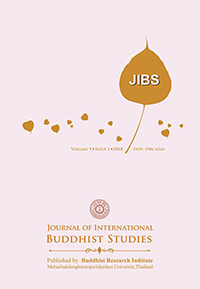An Analysis of Buddhist Ethics in Synshai Literature
Keywords:
Buddhist Ethics, Synshai Literature, Well-related Practice, considerable standard, ethical objectivesAbstract
The purposes of the study were 1) to study the problems of ethics and well-related practice in Synshai Literature, 2) to study the Buddhist ethics in Synshai Literature, and 3) to analyze the considerable standard and ethical objectives of Synshai Literature. This study was a documentary research in which the data collection was by studying the Palm-leaf manuscripts 2016 of Synshai Literature of Khonkaen Synshai Literature transcribed by Mr. Bunkirt Phimvaramethakul and colleagues, and secondary data was by other Synshai manuscripts. The research method was logical consider and analysis, synthesis of all data for new knowledge, and used Descriptive Analysis to present the research result.
The research results were found that an ethical problem in Synshai literature involved with stealing, getting married with many wives, using black magic, and committing adultery. Well-related practice among people was divided into two levels: a domestic level and a relative level. To describe such an ethical problem depended upon Buddhist ethics which was Buddhist knowledge dealt with desirable behavior or manners that people should follow under the standard of Five Precepts. A morality of precept or Dhamma of precept and Buddhist morality consisted of suffering, sexual craving, and previous action under the moral standard of Ten Virtues of the King, and Eightfold Noble Path. The Buddhist doctrine for national management under the standard of ethics stated to the desirable and undesirable ethics. The standard of ethics consideration was divided into two types: 1) the standard relating to Buddhism, i.e. an intention or a purpose to make things wholesome or unwholesome according to moral laws, and 2) the associated standard or the inferior standard which was dealt with conscience principle, what is good or bad, knowing what should behave, and experienced persons’ resolution referring to a brainy person in governing the expression of people in community. The purpose of action in Synshai Literature was to close the gap between a person and associated people and be adorable of a mother, a father, a son and a daughter, and so on.
References
Boonkert Phimworamethakun and colleagues. (2016). Synshai. Khonkaen Palm-Leaf Text.
Duangdean Phanthunawin. (1979). Ethics in Current Thai Society. Bangkok: Religious Department Printing.
Jaruwan Dhammawat. (1958). Esan Literature Style. Maha Sarakham: Siri Dhamma.
Jetsada Thongrungroj. (2004). Philosophy Dictionary: English-Thai. Bangkok: Off-Set Company Press Ltd.
Jinda Duangjai. (1963). Sang Sinlapachai. Khonkaen: Klang Nana Wittaya.
Keerati Boonjuea. (2008). Manual of Universal Ethics. Bangkok: Chain Printing Ltd.
Niyada Laosunthorn. (1995). Jataka Wisdom. Thai Poetry Background. Bangkok: Mae Khanphang Printing.
Peter Whittlesey and Baythong Whittlesey. (2015). Synxay Renaissance of a Lao-Thai Epic Hero. Sinxay Press USA Copyright.
Phattaraphorn Sirikanjana. (2009). A Study of Ethical Concept in Writing Work of Phra Brahamkhunabhorn (P.A Payutto). Bangkok: Thammasart Research Funding Institute.
Phitsanu Sup. (2007). Puzzle of Himavanta. Bangkok: Amarin Printing House Ltd.
Phradhammapitaka (P.A. Payutto). (1997). Dictionary of Buddhism. 9th ed. Bangkok: Mahachulalongkorn.
Phrakru Boonchayakorn. (2004). Synshai. Wat Chaisri. Khonkaen: Khonkaen University.
Preechar Phinthong. (1984). Sang Sinlapachai. Ubon Ratchathani: Siridhama.
______. (1989). Esan-Thai-English Encyclopedia. Ubon Ratchathani: Siridhama.
Sila Weerawong. (1977). Sang Sinlapachai. Bangkok: Sang Sinlapa.
Som Sujira. (1997). Einstein Found and Buddhism Saw. Bangkok: Amarin Printing and Publishing.
Sombat Plainoi. (1983). Mural of Esan. Bangkok: Sinlapabunnakarn.
Somparn Phromta. (1992). Buddhism and Ethical Problems: Attitude of Buddhism in Prostitute Problem, Abortion, and Mercy Killing. Bangkok: Puutachart.
Songwut Siwilai. (2003). Synshai. No. 1-2. Khonkaen: Khonkaen Printing Ltd.
Sowit Bamrungphak. (2009). Morality through Synshai Actors. Khonkaen: Phradhammakanti.
______. Sowit Bamrungphak and colleagues. (2015). Learning Connection: Procedure and Usage of Social Development in Synshai Knowledge of Khonkaen People. Journal of Buddhist Research Institute, Mahachulalongkornrajavidyalaya University.
Suthiwong Phongphaibun. (1982). Analytical Literature. Bangkok: Thai Wattanaphanich.
Suwan Suwanvecho. (2003). Basic Belief of Thais. Bangkok: Krungthon Pattana.
Thawat Punnothok. (1979). Esan Literature. Bangkok: Odian Printing Store.
Theeraphon Namwong. (2014). Esan Poem Storytelling: Synshai. Exchanging Palm-Leaf Book Full Text. Khonkaen: Khonkaen Printing Ltd.
T.W. Rhys Davids and William Atede. (1966). The Pali Text Society’s Pali-English Dictionary. London : Luzac & Company Ltd.
Wasin Intasara. (2006). Ethical Buddhism. Bangkok: Medsai.
Wit Wittawet. (1987). Elementary Ethics: Human Being with Ethical Problems. Bangkok: Aksorn Charoenthat.







